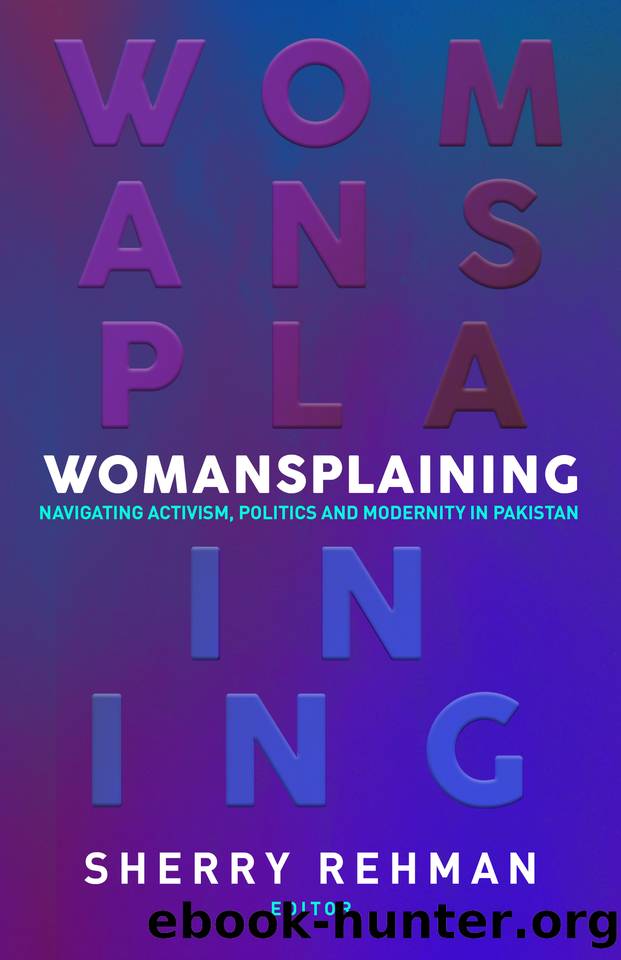Womansplaining: Navigating Activism, Politics and Modernity in Pakistan by Rehman Sherry

Author:Rehman, Sherry [Rehman, Sherry]
Language: eng
Format: epub
Publisher: Folio Books and Jinnah Institute
Published: 2021-07-19T16:00:00+00:00
The picture emerging from the pre-school and primary levels shows that over the last decade, the gender disparity ratio has hit an upper bound. Culture and religion were clearly both used to keep girls out of school. In 2007, in its most violent expression, after the siege of Lal Masjid in the heart of Islamabad, Pakistanâs war on terror broke out of the tribal areas, where it had largely been confined to, and spilled its deadly payload all across the country. The stateâs ambivalent approach to countering the threat in the early years and the support some opposition political parties were lending to the Tehrik-e-Taliban Pakistan (TTP) at the timeâincluding the leadership of the party presently in power, namely the Pakistan Tehrik-e-Insaf (PTI)âleft governments unable to develop a clear public consensus against the threat.
The expansion of the TTPâs influence into Swat and its de facto occupation until operation Rah-e-Rast in 2009 are reminders of the governmentâs impotence and lack of will. While after the Marriott hotel bombing of 2008 in Islamabad government took on the terrorist threat, momentum was lost after 2013 once more; it took the attack on the Army Public School in Peshawar in 2014 for most of the country to converge on the same agenda. Meanwhile, schools, particularly girlsâ schools, in the erstwhile North-West Frontier Province (NWFP, now Khyber Pakhtunkhwa) and former Federally Administered Tribal Areas (FATA) were subjected to violence and bombings by the TTP and, later, occupation by the military during its operations in the area. Some of the increased divergence between enrolment rates between boys and girls can be attributed to the destruction or other dysfunction of hundreds of girlsâ schools during that period.
Another possible explanation is the drop in development funding owing to the recession in 2008. There is plausible concern that enrolment figures may see another veritable hit owing to the damaging effects of Covid-19 on the economy.
Across decades, the gender disparity ratio has always been highest at higher levels of schooling. [103] The increased gender disparity ratio we see at secondary and tertiary levels of schooling can be explained by more even levels of support for education for boys and girls by families with more educated parents who know the value of an education, and wealthier families that are not constrained by monetary considerations of the cost of educating girls. However, even between 2010 and 2018, while the gap between enrolment rates of genders narrowed over the long term, it seems to have stagnated in the 0.85â0.90 range. In 2010, 4.19 million girls remained out of school versus 3.35 million boys. Today, the same numbers stand at 3.6 million for girls and 2.3 million for boys. Participation at different school levels has seen a rise over time, but not enough to put a dent in what is one of the most egregious barriers to girls getting even the most basic education in Pakistan.
Reasons Why Girls Drop Out of School
After pre-school and primary levels, why so many girls drop out of school as we move up the education ladder can be chalked up to a number of reasons.
Download
This site does not store any files on its server. We only index and link to content provided by other sites. Please contact the content providers to delete copyright contents if any and email us, we'll remove relevant links or contents immediately.
| General | Men |
| Women in History |
Cecilia; Or, Memoirs of an Heiress — Volume 1 by Fanny Burney(32026)
Cecilia; Or, Memoirs of an Heiress — Volume 3 by Fanny Burney(31439)
Cecilia; Or, Memoirs of an Heiress — Volume 2 by Fanny Burney(31387)
The Great Music City by Andrea Baker(30759)
We're Going to Need More Wine by Gabrielle Union(18609)
All the Missing Girls by Megan Miranda(14625)
Pimp by Iceberg Slim(13755)
Bombshells: Glamour Girls of a Lifetime by Sullivan Steve(13667)
Fifty Shades Freed by E L James(12889)
Talking to Strangers by Malcolm Gladwell(12826)
Norse Mythology by Gaiman Neil(12794)
For the Love of Europe by Rick Steves(11341)
Crazy Rich Asians by Kevin Kwan(8865)
Mindhunter: Inside the FBI's Elite Serial Crime Unit by John E. Douglas & Mark Olshaker(8669)
The Lost Art of Listening by Michael P. Nichols(7138)
Enlightenment Now: The Case for Reason, Science, Humanism, and Progress by Steven Pinker(6856)
The Four Agreements by Don Miguel Ruiz(6289)
Bad Blood by John Carreyrou(6258)
Weapons of Math Destruction by Cathy O'Neil(5804)
